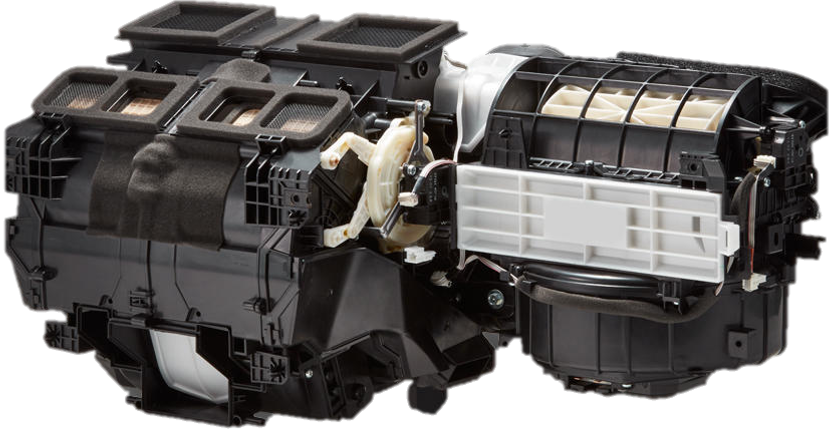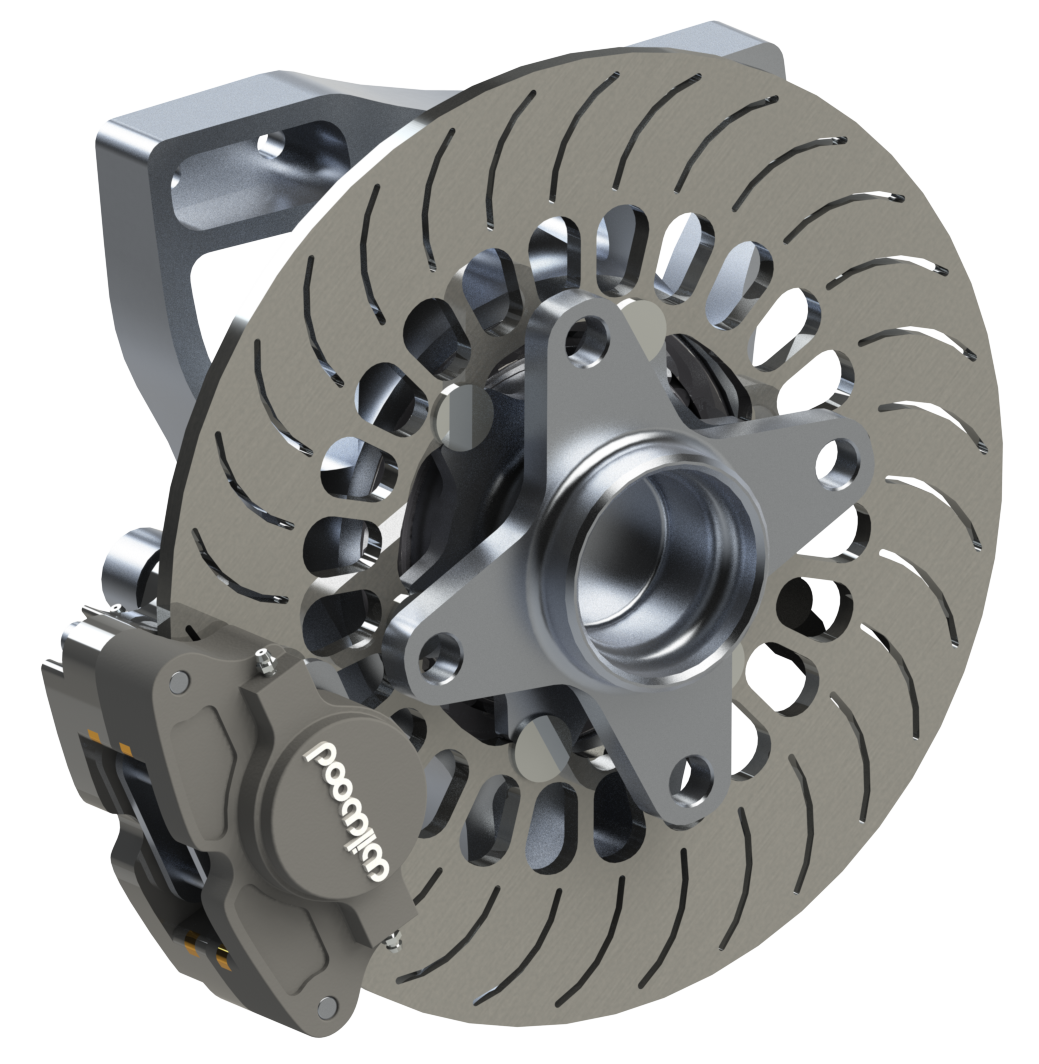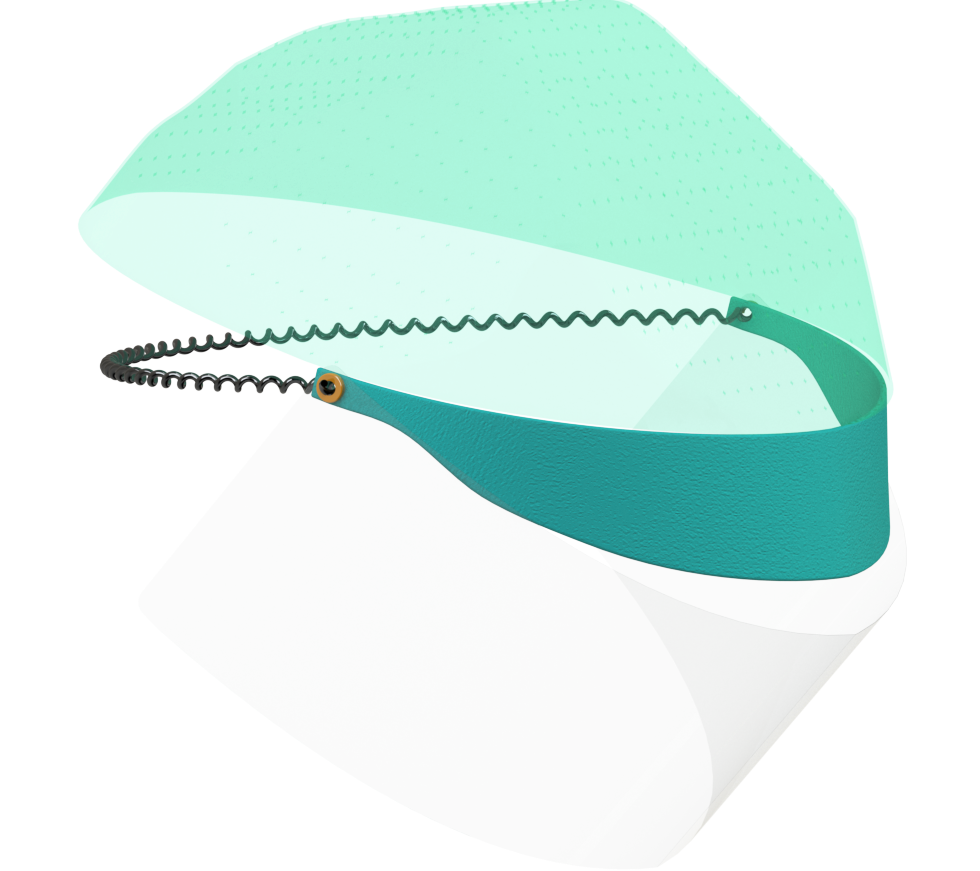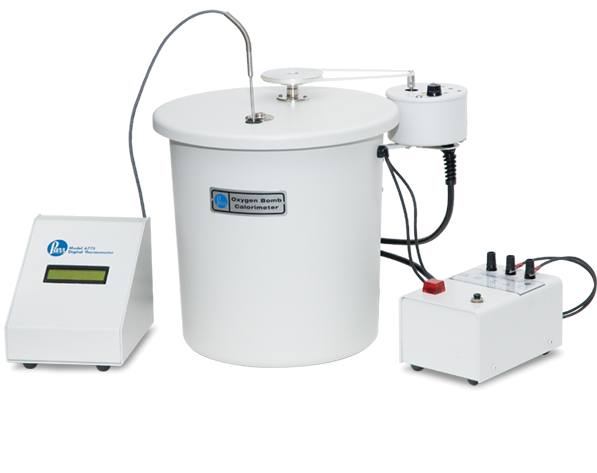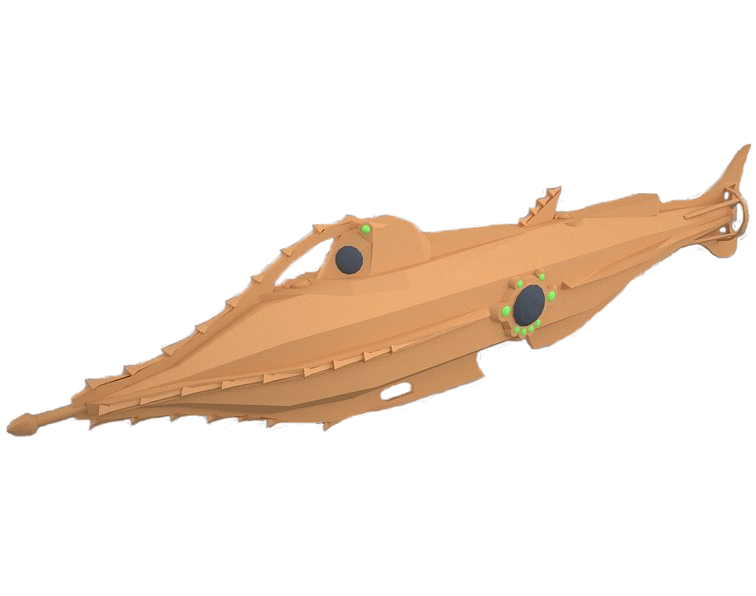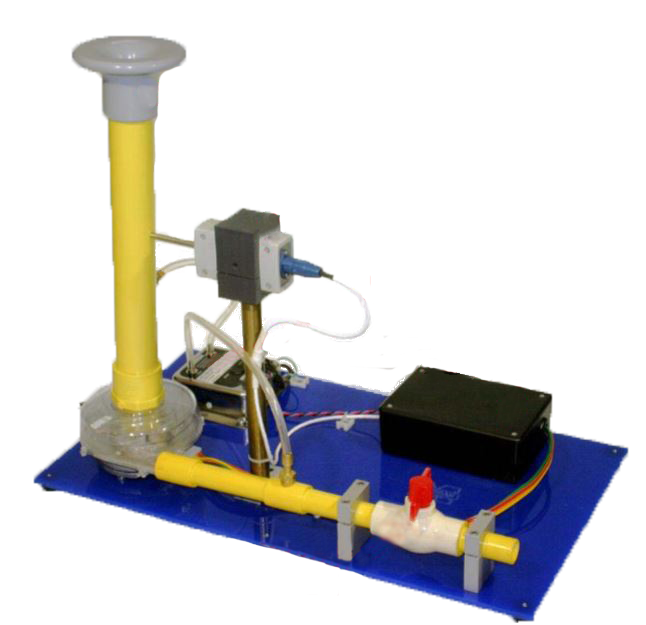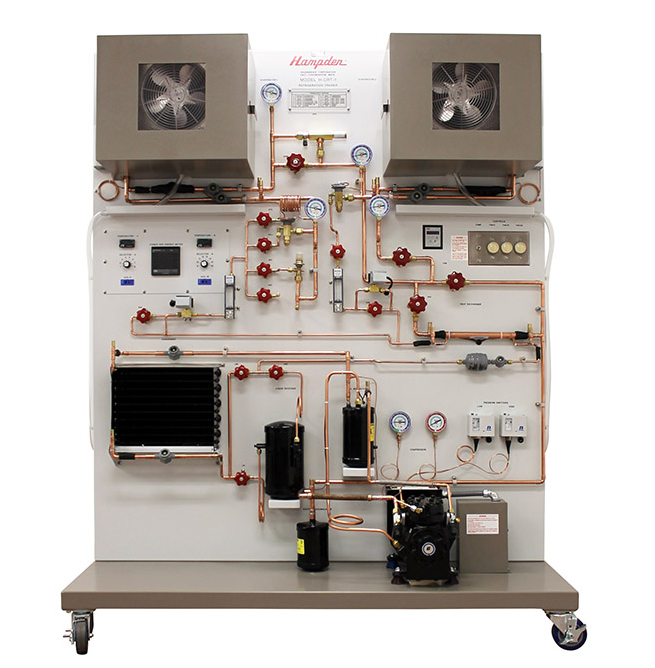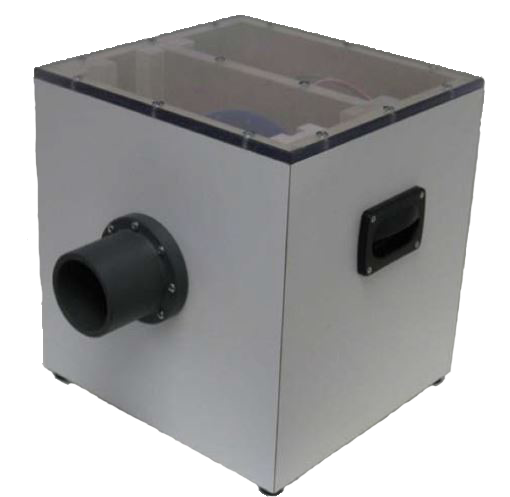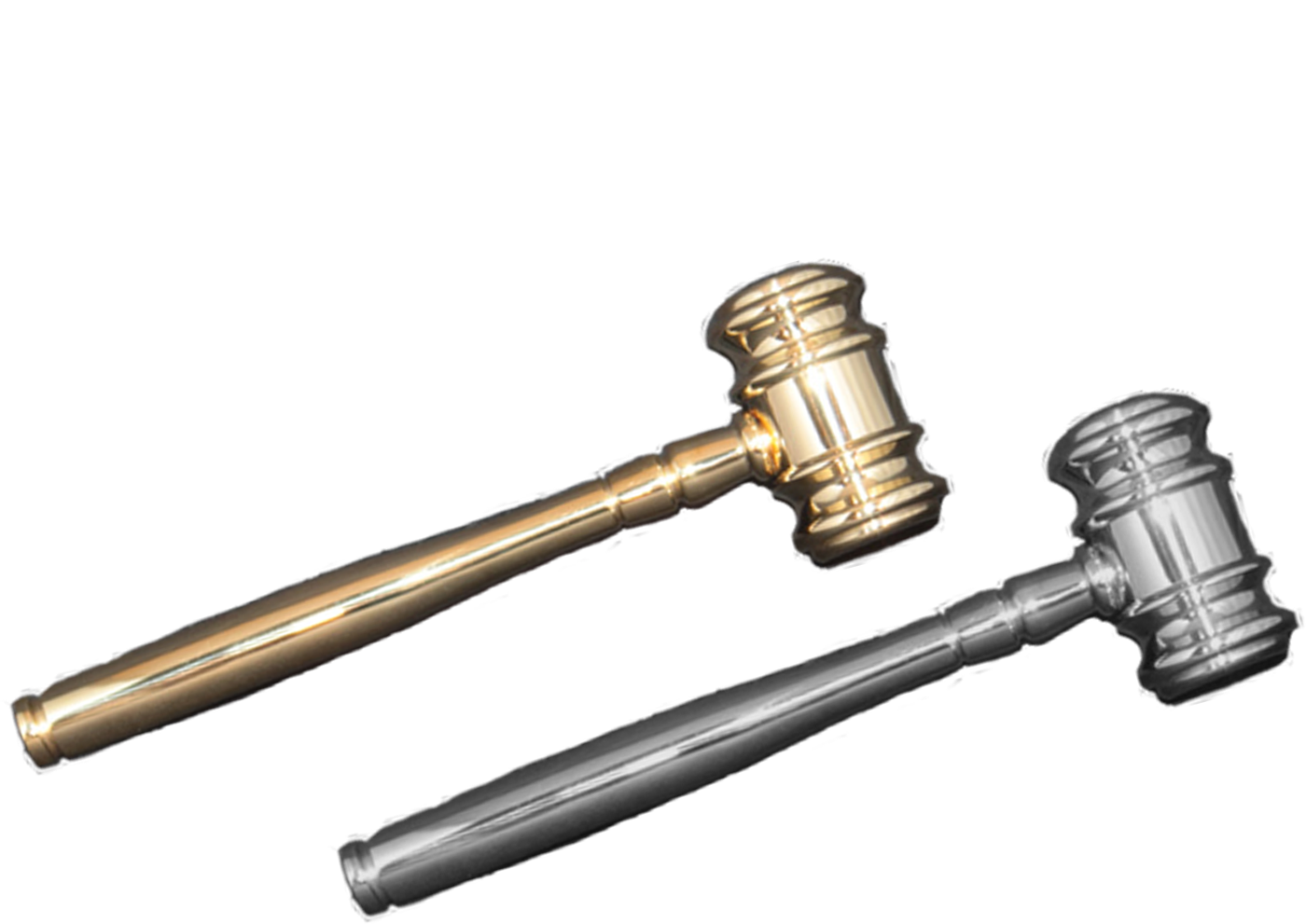
Andrew Paul Wobith
awobith@gmail.com
(616) 283-1392
- Title
- The Garage
- DENSO
- MElectric Racing
- MElectric Project
- MHybrid Racing
- MHybrid Project
- Surgical Eye Shields
- Senior Capstone Project
- Four-Bar Linkage
- Four-Bar Project
- JAMR-250 Robot
- JAMR-250 Robot Details
- Lab Research
- Coding Projects
- Flexible Shaft Details
- Semiconductor Details
- Calorimetry Details
- Cocteau Details
- Turbomachine Details
- Refrigeration Details
- Loudspeaker Details
- Tensile Details
- Contact
Take a look around.
- Title
- The Garage
- DENSO
- MElectric Racing
- MElectric Project
- MHybrid Racing
- MHybrid Project
- Surgical Eye Shields
- Senior Capstone Project
- Four-Bar Linkage
- Four-Bar Project
- JAMR-250 Robot
- JAMR-250 Robot Details
- Lab Research
- Coding Projects
- Flexible Shaft Details
- Semiconductor Details
- Calorimetry Details
- Cocteau Details
- Turbomachine Details
- Refrigeration Details
- Loudspeaker Details
- Tensile Details
- FEA Projects
- Contact
- Home
- Drop a Line.
-
The Garage
In-Vehicle Cabin Climate Control
DENSO's highly integrated automotive heating, ventilation, and air conditioning climate control unit on General Motors' highest volume worldwide platform since 2005.
Michigan Formula Electric Driveline
Incorporates a motor and planetary gearbox encassed within the wheel shell for direct power input to the race car's wheels, achieving a 5:1 gear ratio, torque of 18.4 Nm, and 6% weight reduction.
Michigan Formula Electric Driveline
Re-designed custom uprights for better precision and lightweighting, and developed a new brake rotor with an integrated speed sensor for more efficient heat dissipation and speed measurements.
Michigan Formula Hybrid Powertrain
Developed an adjustable driveline system combining a variety of powertrain components, sliding chain tensioning, a differential, and reduced weight all within a compact package.
Michigan Formula Hybrid Powertrain
Lightweight 36-tooth driveline sprocket optimized to provide a power output that aligns with the EV drivetrain on MHR18.
Easy-on easy-off OR equipment
Clear, comfortable, non-distracting shields that easily snap onto prescription glasses for use in the operating room based on the AORN guidelines for surgical attire.
Universal Shield OR equipment
An adjustable shield for all head sizes that incorporates a hairnet for increased compliance in the operating room and meets the AORN standards for surgical attire.
Ball Collection & Sorting
Designed and built a 4-bar linkage that catches, sorts, and delivers colored marbles into one of two bins using mechatronics and an assortment of sensors.
Game of Zones
Compact redesign of JAMR-250 with better maneuverability, lower center of mass, and a pneumatic grasper capable of carrying more cubes per trip
Game of Zones
A remote-controlled robot with a planetary gearbox drivetrain and uses a rack and pinion grabber attached to the end of a ramp to grab, transport, and deliver cubes across a wide variety of terrain.
Drivetrain Vibrations
Identifying excessive vibrations experienced by passengers in a hybrid powertrain driveshaft, resuling in 4 design modifications that reduced resonance by 30+%
Thermal Management Strategy for Microprocessors
Examined methods to maintain chip operation temperature below 80°C by analyzing the effective thermal transport of a variety of heat sinks.
Fuel Consumption & Advanced Powertrains
Assessed the impact of of low carbon fuels with advanced vehicle powertrains on GHG emissions, using the ASTM D240 standard.
Non-Dimensional Analysis
Determined the feasibility of a deep-sea AUV with a 0.5m3 volume, operating temperatures as low as 5°C, and the power consumption required to achieve autonomous operation at 0.9 km⁄hr
Miniature Turbomachine
Analyzed the pressurized flow across a vacuum pump and the corresponding non-dimensional coefficients in order to determine the scalability of a pump to meet a flow rate of 0.85 m3⁄min.
Analyzing the Vapor-Compression Cycle
Investigated the cooling capacity and COP of a commercial refrigerator to be used in extreme environments that can reach temperatures as high as 45°C.
Acoustics & Impedance
Compared the soot cleaning capabilities of loudspeakers using acoustic agglomeration of particles for use in power plants.
Tensile & Fracture Testing
Determined the suitabilty of 7075-T651 aluminum to replace naval brass in gavels by examining their material properties through tensile and fracture testing.
-
DENSO
Tier 1 Automotive Supplier

Crafting the Core
Developing innovative, eco-friendly, and smart solutions is what motivates DENSO to design high-quality automotive products. As the second largest Tier 1 supplier, DENSO produces high performance technologies without sacrificing security, safety, and environmental impact. These principles help foster powertrain solutions with better fuel and battery efficiency, as well as future COA HVAC programs pushing DENSO towards a more efficient, modular, and environmentally friendly approach to climate control design.
As a Mechanical Co-op within the General Motors climate control team for three consecutive semesters, I performed thermal, fluid, and mechanical analysis and testing throughout the lifecycle of HVAC programs. I gained experience with the entire design process, from designing a product, quoting it, carrying out preliminary testing, developing DFMEA worksheets, and securing business, to finding solutions for plant-side mass production issues and validating the HVAC systems. Working at DENSO allowed me to apply my knowledge of heat transfer, thermodynamics, and mechatronics towards designs that have a beneficial impact on people's lives. In addition, I also volunteered within the company in organizations such as Coops-4-A-Cause to help out the local community.
Automotive HVAC Design
DENSO's HVAC systems incorporate a variety of inputs from the passenger(s) and electronic sensors to regulate the cabin's temperature, humidity, and air flow. Properly managing these elements helps to create a comfortable environment and reduces the number of distractions for occupants while driving.
In my role as an application design engineer I had the opportunity to apply my knowledge of heat transfer, mechanical design, and manufacturing towards complex HVAC systems with a focus on quality, constant improvement, and cost savings. At DENSO, there are 3 important design considerations to evaluate throughout the design process: (1) the customer's comfort, (2) safety and security, and (3) system performance. Creating an experience that combines all of these elements is something that DENSO strives to accomplish in every step of the design process. Noise, humidity, extreme temperatures, and comfort all should be controlled for the occupants to minimize as much of their distractions from the road as possible.
At DENSO I was given opportunities to make an impact throughout the HVAC design process using:- DFMEA to identify potential failure modes for components and subsystems.
- 3D modeling and 2D drawings in Siemens NX, with an emphasis on GD&T and manufacturability.
- Issuing engineering change instructions (ECI) to address production issues.
- VAVE cost reduction and benchmarking activities.
- Heat transfer and thermal manamgement design.
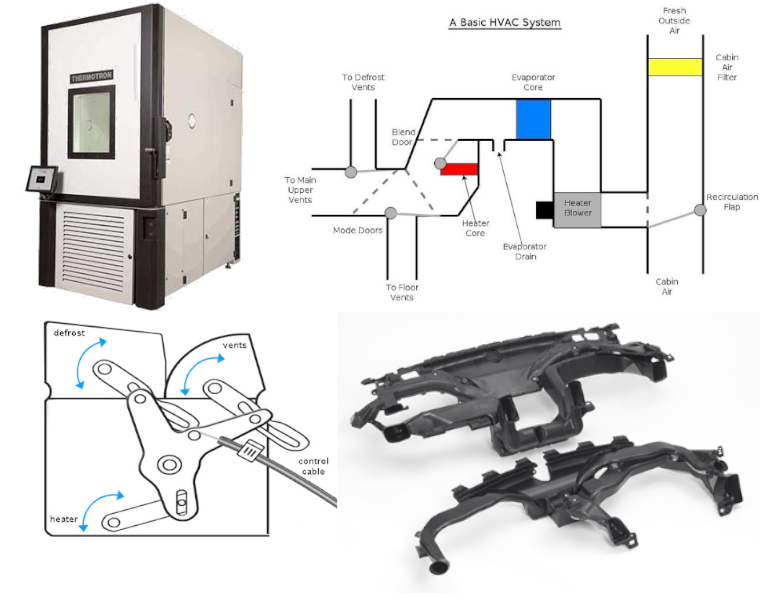
Analysis and Testing
DENSO's HVACs go through rigorous DV and PV validation process throughout the design, testing, and manufacturing phases. From creating test procedures to performing data analysis in Excel, I helped verify that our HVAC systems met the customer expectations both on an assembly and component level. I frequently participated in VAVE opportunities to uncover and implement cost-effective solutions.
Engineering analysis:- ADVP&R analysis development validation plan and report procedures
- Design and Production Validation Testing (DV/PV)
- Helped create a new control box to actuate LIN Step motors during testing for a new prototype HVAC program.
- - Controlled thermal and vibration cycling throughout the expected life of the HVAC (nearly 200,000 cycles).
- - Programmed in Arduino, developed a UI system for technicians, and coordinated with departments in the U.S. and China for common test procedures.
- Validated 30+ service production parts, working with suppliers and manufacturers to validate components against new GM specificaitons.
- Evaluated experimental values and compared them against customer and internal specifications.
- Examined large warranty databases from technicians and used machined learning with VBA to isolate issues and identify proper countermeasures.
- Developed presentation material and provided design recommendations based on the analysis.
Additional testing:- Experience with Thermotrons, vibration shakers, anechoic NVH chambers, climate controlled rooms, variety of sensors, and data collection.
- Motor actuation cycling at different temperature conditions (-40°C to 80°C) to evaluate mode door positioning and linkage grease performance.
- Torque testing to evaluate torque margins as the linkage mechanism moves from one extreme to the next (ex: From Defrost to ).
- Airflow and temperature distribution at each duct outlet - compared to GM specifications.
- FOD seal water leakage testing around the TXV valve for both spray and immersion to mimick in-vehicle conditions.
- FOD seal material interaction with various compressor oils.
- Wire Harness clip deflection to improve the production assembly line.
-
Michigan Electric Racing
Multidisciplinary Student Formula Electric Team
Driven by Innovation
During the transition to an all-electric vehicle for the 2018 - 2019 season, I shifted over to the Driveline division in a lead design role where I developed our new in-hub and corner assemblies for the MER19 car. Prior to the start of the season, we extensively researched how to design a formula-electric vehicle and performed benchmarking against other teams in order to set ourselves up for success in an entirely new competition. The architecture for this system was chosen to maximize the transmission ratio, improve heat dissipation and braking, and reduce the overall unsprung assembly weight. The combination of the upright, hub, and transmission housng provides an efficient and lightweight way to package the in-hub entirely within the wheel sheel of the tires.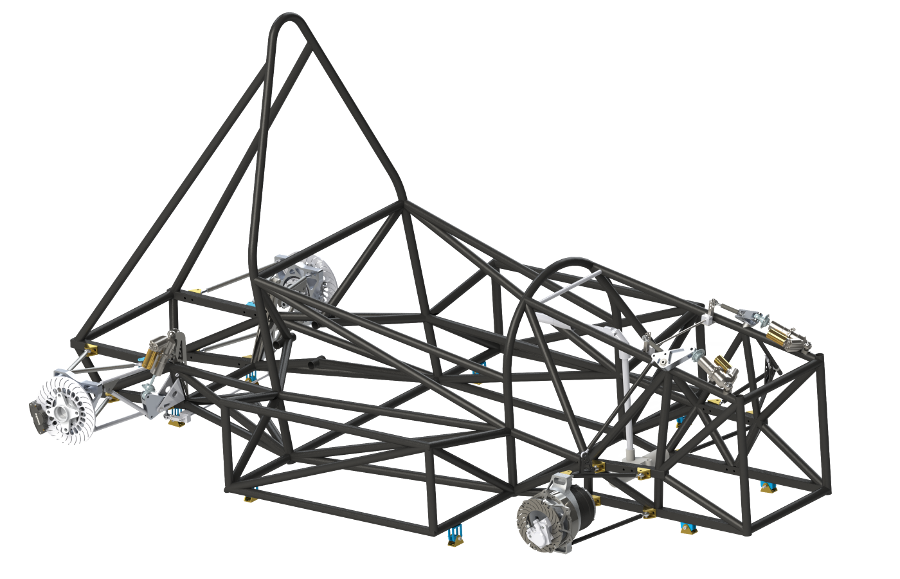
From Hybrid to All-Electric
For the 2018-2019 season, a new EV drivetrain needed to be developed that addressed the issues we experienced in prior competitions and improve the overall performance of the vehicle. As the Driveline division's lead design engineer in charge of the corner architecture for the front and rear wheels I managed the analysis for the brake calipers/discs, motors, transmission, packaging, and driving performance on the race track. Components were modeled in SolidWorks, FEA analysis was done in Ansys and HyperWorks, manufacturing drawings were drafted per ASME-Y-14.5-2009, and critical parts were sourced with help from sponsors.
The final driveline assembly had to meet the Formula SAE Electric rules, among which include:- The wheels must be secured to the suspension by an upright
- Uprights must support the weight of the car, as well as acceleration in all directions due to braking & cornering
- Uprights must be able to transfer power to the wheel through bearings & hubs
- The front corner must include a steering linkage

Front Corner In-Hubs
Lightweight redesign with improved heat dissipation, integrated planetary gearbox, a custom built inverted brake caliper, and a brake fluid line rerouting path all packaged within the wheel shell.
We examined 5 key aspects to increase the performance:- Assembly packaging and caliper access
- Heat Dissipation and Braking
- Transmission design
- Unsprung weight reduction
- Race track analysis
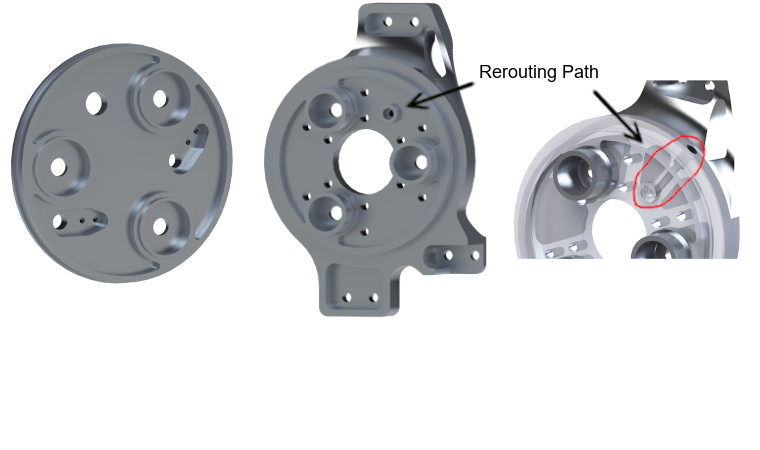
Uprights
Inner half of the tranmission enclosure encassing the motor and planetary gear assembly. Consists of an inner and outer section that withstands the loads of the A-arms, steering tie rod, and pull rod for the front suspension. In addition, the uprights offset the rotational axis of the wheel from the vehicle through 2 SilverThin section bearings. A brake line rerouting path was machined from the inner and outer upright in order to provide better access to the calipers due to the inverted caliper design.Features:
- Material: 7075-T6 Aluminum
- Inner Upright: 850 grams (5.45% decrease), 1.53 SF
- Outer Upright: 361 grams (27.4% decrease), 4.0 SF

Planetary Gearbox
Consists of a 27-tooth Hessmer sun gear, three 54-tooth fixed planets, and an outer 135-tooth ring gear that rotates about 2 Silvethin section bearings. The frictional force between the ring gear and the shrink fitted bearings counteracts the largest torque seen at their interface. The planets rotate about a fixed axis, with deep groove ball bearings to support the radial and axial loads.
With its high drop point, friction reduction, and overall performance, Lucas Oil G3 Racing Grease was used between the gears to withstand the extreme pressures and temperatures and reduce friction during operation.Features:
- Plettenberg Nova 15 motor (max speed of 8000 rpm)
- Planet Gears: SKF 63806 Deep Groove Ball Bearings
- 5:1 Gear Ratio, torque output of 92 Nm
- Gear Assembly mass of 105 grams (48% decrease from prior year)

Inverted ISR Calipers
Due to the geometry of the in-hub system, size contraints, and the operating conditions of our vehicle, a new brake system needed to be designed. To solve this, internally mounted calipers had to be used with externally mounted rotors. This proved to be challenging as there are no commercially available brake calipers intended for internal mounting. Due to the mounting location, a new brake line path had to be developed to access the calipers.
In order to gain the maximum pad contact with the rotor, custom brake pads were purchased from Porterfield based on standard ISR pads. By extending the arc outside of the pad, the contact area was increased while minimizing the extra forces and moments experienced from contacting farther from the center of the caliper piston. Using a Carbon Kevlar compound, the R4-1 pad material is ideal for our required friction and temperature conditions.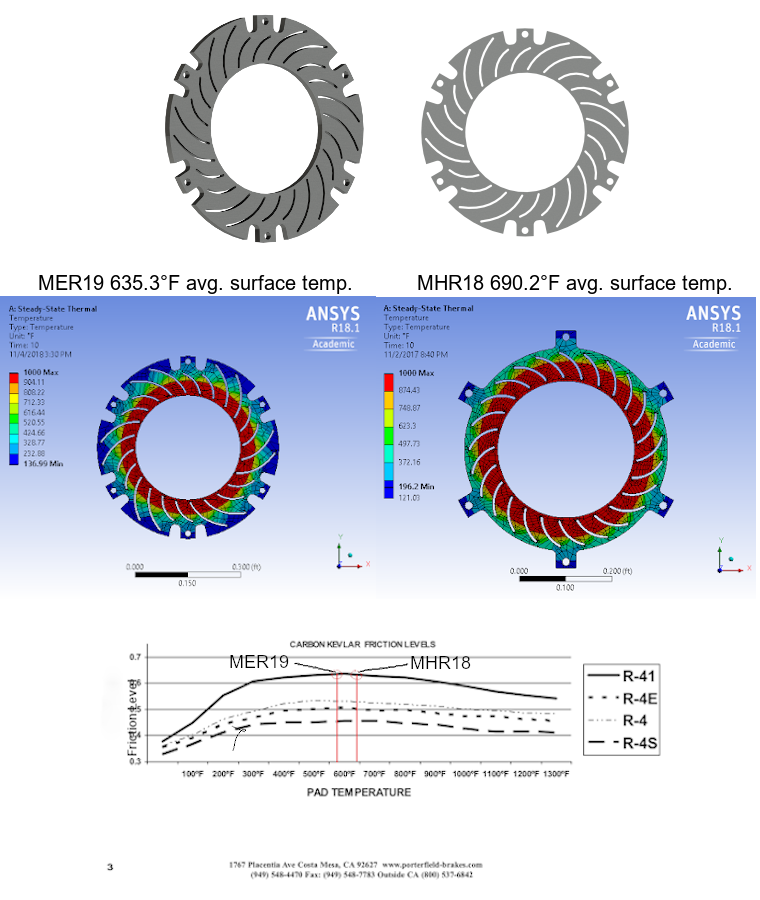
Front Brake Rotor
After extensively researching FSAE brake systems, the design of the front rotor was determined by the material, the available space within the wheel shell, and the ideal geometry that optimized heat dissipation. High carbon steel was chosen due to its excellent heat dissipation qualities during braking based on an energy conservation analysis. The slot patten reduces brake pad wear while maximizing heat dissipation. Having a cutout geometry creates a "fan-like" effect to flush out the gas layer between the brake pads and rotor. Using a 0.25 inch slot thickness ensured that more heat was conducted through the material based on our optimal weight to heat dissipation ratio. Using a 4 second braking simulation from 40 to 0 mph, the brake rotor's average surface temperature was found to be 635.3°F - a decrease from 690.2°F from the prior year. This average operational temperature was ideal for our brake pads, improving our braking performance.- High Carbon Steel was chosen due to its heat dissipation properties during braking
- 78.28 mm OD (inside wheel shell), 45 mm ID (caliper inside rotor), 6 mm thickness (width between brake pads)
- 29.98% increase in Surface Area, 37.33% increase in weight & volume, 7.96% increase in avg. heat dissipation
- Due to a lower average braking temperature, the brake pads have higher a kinetic coefficient of friction (from 0.63 to 0.64). This led to an increased braking performance of 1.59% at maximum performance
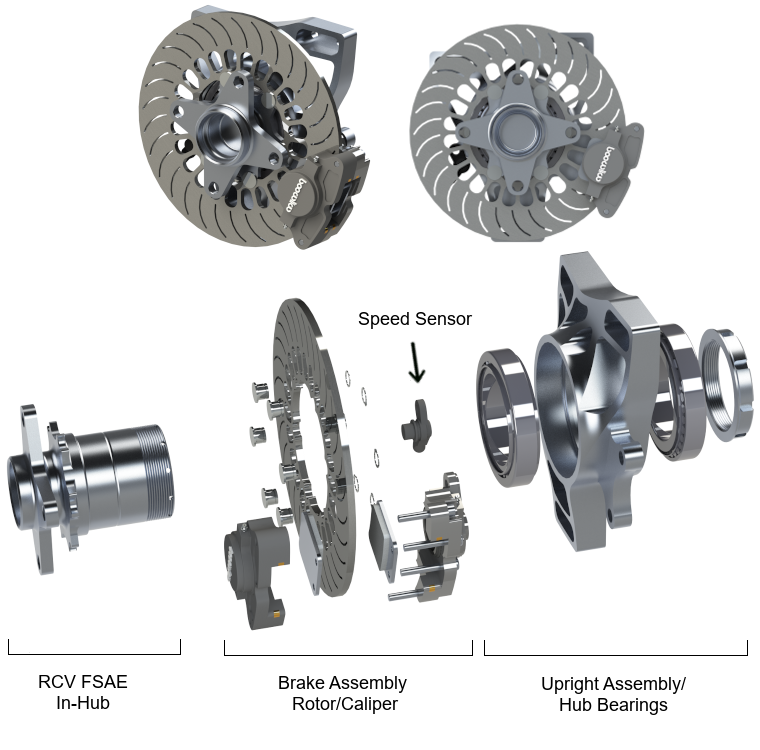
Rear Corner In-Hubs
Redesigned the prior year's rear corners with a new brake assembly and integrated speed sensor. A series of 24 holes were cut out of the brake rotor in order for the speed sensor to get an accurate reading of the wheel's speed. The uprights were re-manufactured for better precision and modified to include a mount for the sensor. A thermal braking analysis was carried out in Ansys to optimize the heat dissipation of the brake rotor. External Wildwood GP-200 Calipers were used that provided ideal pad contact and friction with the rotor surface. The RCV FSAE in-hub was a carryover component from the prior year that determined the internal mounting holes on the brake rotor.
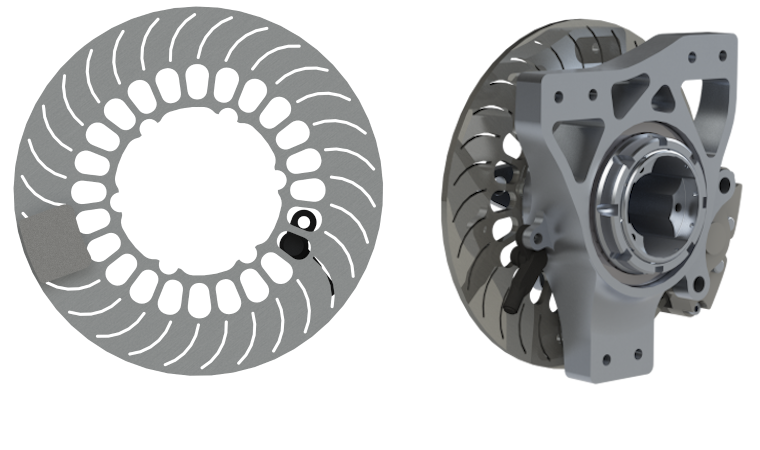
Rear Brake Rotor
The goal for the rear rotor design was to maximize the number of speed sensor ticks while minimizing the weight. We also wanted to eliminate an additional wheel speed sensor component by using the brake rotor. The rear hub provided the internal mounting holes, while the outer diameter was constrained by the wheel shell. Similar to the front rotors, the slot pattern was chosen to minimize pad wear and increase heat dissipation. In between the pad contact area and the internal mounting, including speed sensor cutouts helped to trim some of the weight. In total, 24 ticks were chosen to allow for minimal weight while maximizing the accuracy of the speed sensor.
- Material: High Carbon Steel
- Built-in speed sensor with 24 slots cut out of the rotor for more accurate sensing of the wheel speed
- Wilwood GP-200 Caliper, R4-1 carbon kevlar brake pads
-
Michigan Hybrid Racing
Multidisciplinary Student Formula Hybrid Team
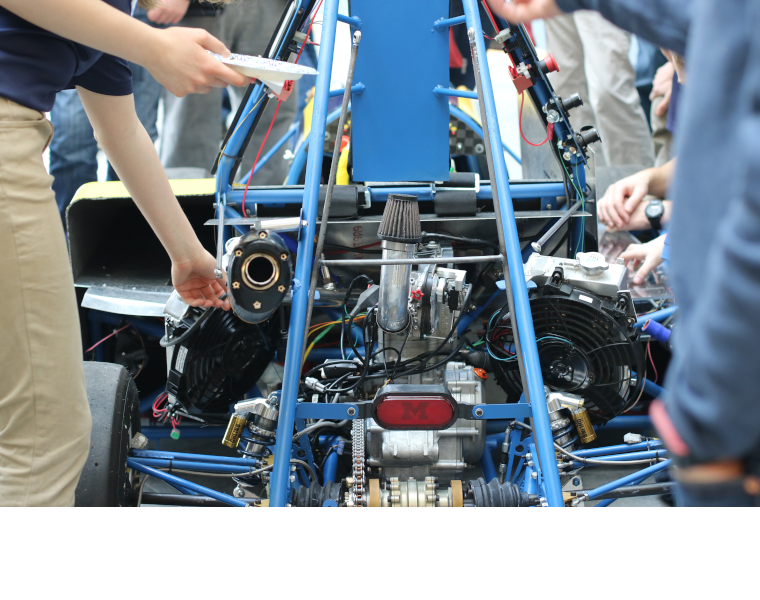
Hybrid Design
Michigan Formula Hybrid Racing is a student-run interdisciplinary design team working collaboratively to build a formula-style hybrid race car and compete in a series of events at New Hampshire Motor Speedway, New Hampshire. The competition emphasizes drivetrain innovation and fuel efficiency in a high-performance application across mechanical, electrical, and computer engineering disciplines. During the 2017 - 2018 season, I joined the Internal Combustion Engine Division for MHR-18 where I developed powertrain components, including an adjustable drivetrain, electronic clutch, and a modified driveline sprocket.
Internal Combustion Engine Division
Our goal as the ICE division was to design and manufacture a cohessive and high performance rear wheel drive system that was optimized to match the power output of the EV powertrain. Each component was analyzed to ensure compliance with our design requirements with a reasonable safety factor.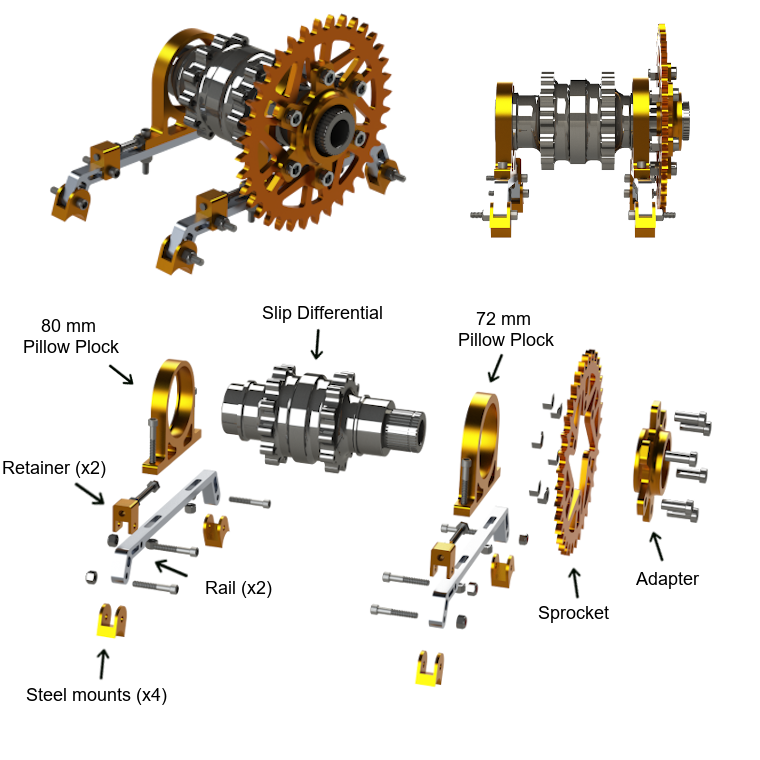
Adjustable Driveline System
Designed with a continuously-adjustable linear chain tensioner, final transmission ratio of 4:1, and differential rails that span the length of the engine chassis tubes for rigid mounting.Based on prior vehicles and additional testing, a higher safety factor was added to the rails and pillow blocks to prevent plastic deformation and resist bending.
Features:
- Drexler adjustable limited slip differential
- Pillow Block Bearing Carriers
- 72 mm diameter, 6061 Aluminum, 2.16 SF
- 80 mm diameter, 6061 Aluminum, 2.07 SF
- Retainers - 6061 Aluminum, 2.14 SF
- Steel Mounts - AISI 1018 Steel, rubber washers for vibration damping, 5.28 SF
- Differential Rail - 6061 Aluminum, 2.34 SF
- 36 tooth Sprocket - 7075 T6 Aluminum, 3.87 SF
- Sprocket Adapter - 7075 T6 Aluminum, 2.92 SF
- Final build cost of $4,320, with a mass of ()
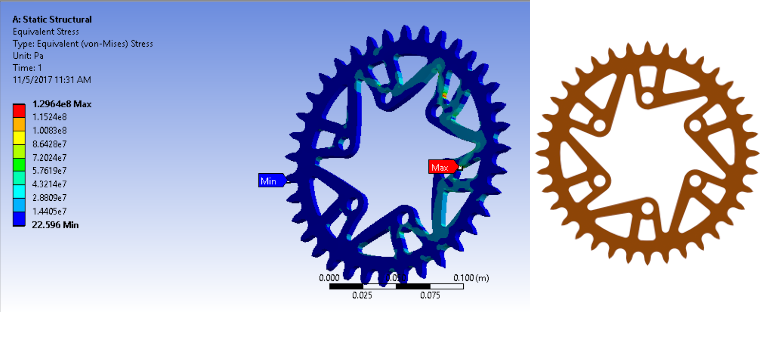
Driveline Sprocket
New driveline sprocket for MHR-18 that was lightweighted based on FEA and uses a smaller gear ratio to provide a torque output that is more aligned with the EV drivetrain.Features:
- 7075-T651 Aluminum (Yield Stress of ~505 MPa)
- Max von Mises Stress of 129.6 MPa.
- Used Chassis dyno performance to determine the best gear ratio that aligned the power output with the EV drivetrain.
- 36:13 gear ratio, reduced from 44:13 from the prior year. This allows for an increase in speed with a decrease in torque output.
- Lightweighted to 246 grams with a 3.87 Safety Factor, 1.9 inch circular bolt pattern, and less rotational inertial.
-
Surgical Eye Shields: Senior Capstone
Personal Protective Equipment for the OR
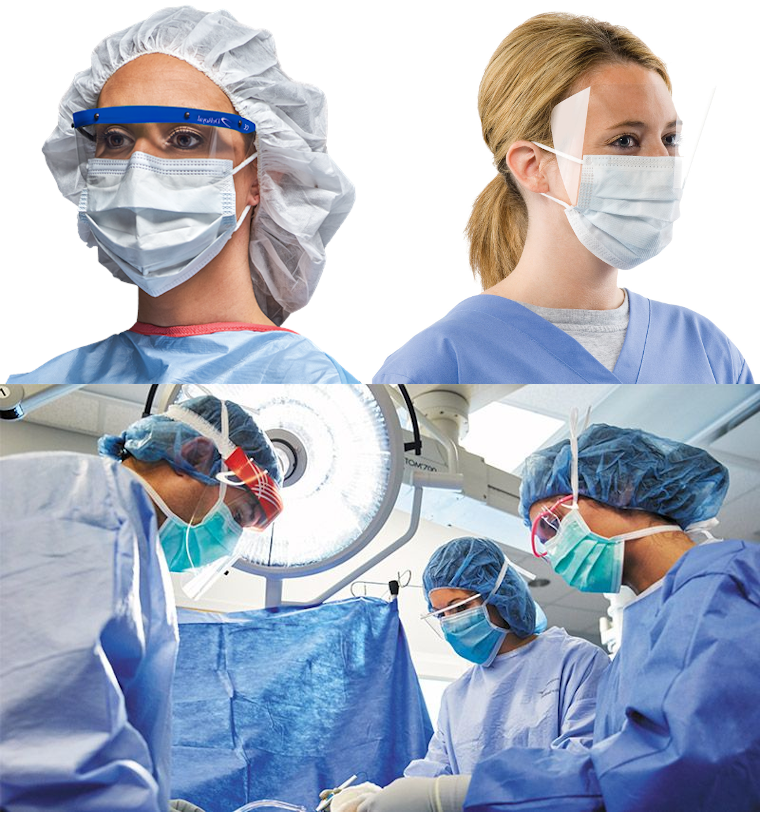
Project Overview
Wearing personal protective equipment (PPE) is a standard operating procedure for physicians and nurses in the operating room. When performing a surgery, the operating surgeon is put at risk of bodily fluids coming in contact with unprotected skin and spreading contaminants. This is especially important for the ophthalmologists working at the University of Michigan Kellogg Eye Center, where an estimated 83.4% of blood splashes occur to the face - of which 66.7% occur to the eyes.
PPE is required to be worn during an operation, but there is no standardized eye protective equipment that all surgeons use. Current eye shield PPE designs exhibit high glare, are difficult to attach and remove, can cause wear and tear to prescription glasses, and are quite uncomfortable when used for long periods of time. In addition, these designs must pass medical standards established by the Association of Operating Room Nurses (AORN) standard for proper eye protection worn in the operating room during surgery.
Working alongside Professor Alan Taub, a faculty member with the Mechanical and Material Science and Engineering departments, and Dr. Christine Nelson, an ophthalmologist at the University of Michigan Kellogg Eye Center, our team developed 2 final prototype solutions that addressed the concerns established by the medical staff we consulted with and catered towards two different end users. Our designs were created from the ground-up through weekly design reviews, rigorous validation testing, and prototype construction incorporating user-driven feedback from nurses and doctors. Both designs meet the AORN standard for proper eye protection in the OR room, and they exceed the functional and engineering requirements established by our team, Professor Taub, and Dr. Nelson.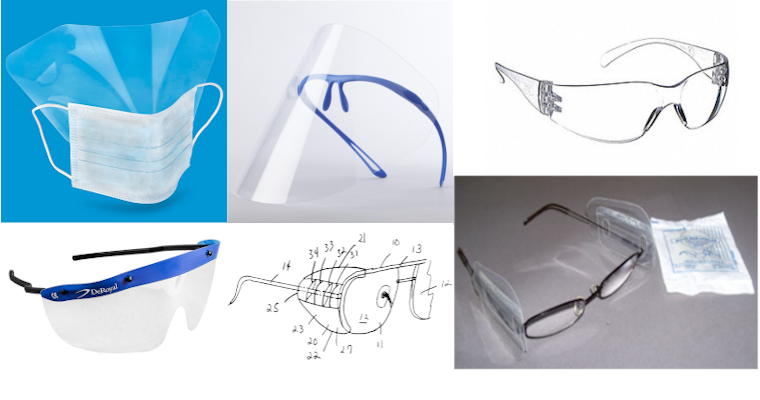
Current Solutions
During our initial benchmarking phase, our group met with Dr. Nelson to determine the essential customer requirements we would need to translate over to engineering specifications. Several requirements were inspired by what current designs in the market have tried to address - particularily high optical clarity, comfortability, a user friendly design, and shields that pass the auditor requirements in the operating room. During our research, we came upon several competing examples that offered unique solutions.
After talking with other doctors, nurses, and operating room staff, as well as getting the opportunity to test drive some of the current designs ourselves, it was evident that the current solutions did not address several key functional requirements. Users experienced high glare, difficulty in removing or attaching the equipment, and discomfort when used for long periods of time. These attributes create extra distractions for nurses and surgeons, especially during long surgeries. Due to the lack of requirements from OSHA, CDC, and AORN, the current eye protection technologies differ vastly in appearance and functionality for medical procedures.
Defining User & Engineering Requirements
User requirements were determined after discussions with Dr. Nelson and members of the Ophthalmology nursing staff. These requirements were ranked into tiers based on their importance to the design, with Tier 1 being critical and Tier 4 being non-essential features. In order of importance, the following are the key user requirements we aimed to meet with our final designs:- Tier 1: Optical clarity; Auditor OR requirements
- Tier 2: Non-distracting; Comfortable; Easy on / easy off at microscope; One size fits all; Low cost
- Tier 3: Stability; Lightweight; Useable with and without prescription glasses
- Tier 4: Non-damaging to glasses; Cleanable during surgery
After iteratively refining our designs and carrying out validation testing, we arrived at 2 final prototype designs that have many advantages over the competition. The prototypes possess high visual clarity and are comfortable to wear for long periods of time - ideal for long surgeries. They experience much less glare, are easy to attach and remove, and create less distractions for users during use.
Clip-On Side Shields
The side shields are designed to fit on the majority of temple frame styles for prescription glasses as an easy-on, easy-off pair of shields. The shields are made out of a thin acetate sheet, two flexible polycaprolactone thermomorph clips attached at one end with adhesive, and a strip of foam glued along the inner surface of the clips for better stability. The shields easily attach from the top of the temple frames and can be adjusted to the correct alignment for each user. The clips are placed towards the back of the shield in order to remain outside the users field of view and minimize distractions. The shield dimensions are 70mm x 60mm and pass the AORN standards for proper surgical attire.Product Features:
- High Optical Clarity due to flat shield geometry
- Validated for comfortability, stability, optical clarity, and blood spray testing
- Easy to adjust and clips onto a majority of temple frame thicknesses
- Non-distracting and experiences little to no glare
- No observable scratching on prescription frames
- Total Mass of 4 grams (2 shields)
- Final cost of $0.93 per pair (2 shields)

Hat & Visor
The Hat & Visor shield is comprised of the following subsections: a foam visor, an elastic strap that wraps around the back of the user's head, an integrated surgical hairnet, and a full-face shield that can pivot at the temple. The surgical cap was integrated into the design in order to encourage compliance with the OR staff. The shield is made out of acetate sheeting that is cut and sized to the predetermined dimensions. While in use, the sheeting does not fog and the glare rating is low which satisfie the engineering and user requirements for optical clarity and anti-glare. The Hat & Visor is a solid universal solution for all head sizes that meets the AORN standards for proper surgical equipment.Product Features:
- Full-Face Shields that can pivot out of the way to use microscopes
- Validated for comfortability, stability, optical clarity, and blood spray testing
- Increased compliance and mets operating room requirements
- Conforms to a majority of head sizes
- Mass of 20 grams
- Final cost of $1.91 per unit
Documentation -
Four-Bar Linkage
Ball Collection & Sorting

Project Scope
The ME 350 Design & Manufacturing course at the University of Michigan provides students with the opportunity to develop a mechanism that will catch falling balls released at random into a cup, recognize their color, and then deposit the balls in the appropriate end basket or net. As part of a team of 5 students, my group created a four-bar linkage by applying our knowledge of mechanical design, sensors, and controls to safely and efficiently intercept the balls as they are dropped and deliver them to the correct location. In order to be successful, the mechanism had to meet the following requirements:- The final mass must be less than 3 kg.
- The transmission angle must fall between 30° and 150° (90° being optimal).
- The team can choose between a 1 or 2 inch diameter cup, with no further modifications made to the cup. The 1 inch cup receives a 1.5x point multiplier.
- The linkage must be able to mount within a predefined 4.5 in x 6 in region at the bottom of the playing field.
- Once mounted, the linkage system must be calibrated with limit switches placed by hard stops, and then set to a random start position. It must be able to operate fully from any starting position.
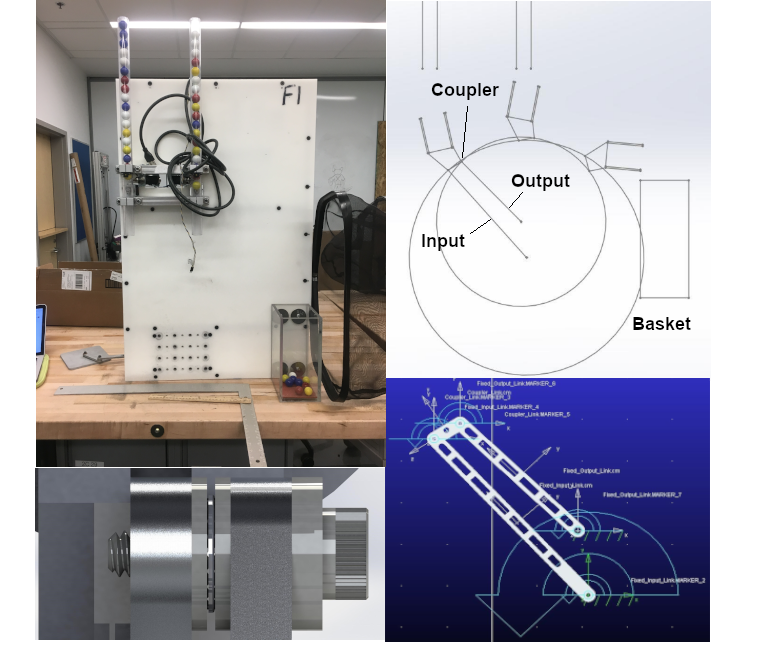
Design & Modeling
The design process started with a motion generated kinematic model in SolidWorks that prioritized the positioning of the coupler link throughout the range of motion using linkage equations, degrees of freedom, and transmission angles. Each group member produced one design concept (5 total), and then generated their linkage geometry in 3D within SolidWorks. These models were then imported into ADAMS for a kinematic study to determine the velocity, power, and input torque required to move the linkage throughout its range of motion. Using a Pugh Chart to compare each individual design based on the overall weight, geometry, power, transmission angle deviations, and manufacturability, our team selected the best design that met our functional requirements and chose to use a 2 inch cup.
The linkages, spacers, and baseplate were made using 6061 Aluminum. Washers, thrust bearings, shoulder screws, and bushings were integrated into the joints between the links to minimize the amount of friction while transitioning from one position to the next. A CLC fixture was 3D printed to fasten onto the coupler link and attached the cup onto. The cylindrical hardstops were designed to be adjustable to make fine-tuning for the initial and final positions an easier process later on. A combination of dowel pins and mounting screws were used to fasten the baseplate to the play field.
Each of our components were manufactured using waterjets, lathes, mills, and 3D printing. We drafted drawings according to ASME-Y-14.5-2009 and developed our own manufacturing plans for a safe and effective machining process.
Analysis
The full range of motion of our model was analyzed within ADAMS to optimize the linkage's motion and generate the fastest, most effective movement. This analysis provided us with the angular position, velocity, torque of the input link, and power consumption throughout the range of motion.
Using the data collected from ADAMS, our team created the transmission system required to effectively convert the output torque and power from the motor to the linkage. A conservative transmission ratio of 4:1 was selected by comparing three different methods: inertia matching, gravity compensation, and cup resolution. Gears were chosen for the transmission, which allowed us to meet the torque requirements of our mechanism with high accuracy and speed in a smaller package. Once the transmission was finalized, the total mass of the entire four-bar linkage assembly came to 1.47 kg.
To calculate the minimum amount of time required to transition from the rightmost position to the leftmost, we needed to perform a power analysis. Based upon the motor specifications, linkage inertia, angular velocity, acceleration, and torque, we arrived at a minimum travel time of 0.356 seconds.
Next, the torque transfer of the transmission was analyzed by examining the joints between the (1) motor and output gear and the (2) output gear and the linkage. By examining the stresses experienced at these locations and comparing them to the fracture and yielding conditions, we determined that our transmission setup could withstand the torque from the motor.
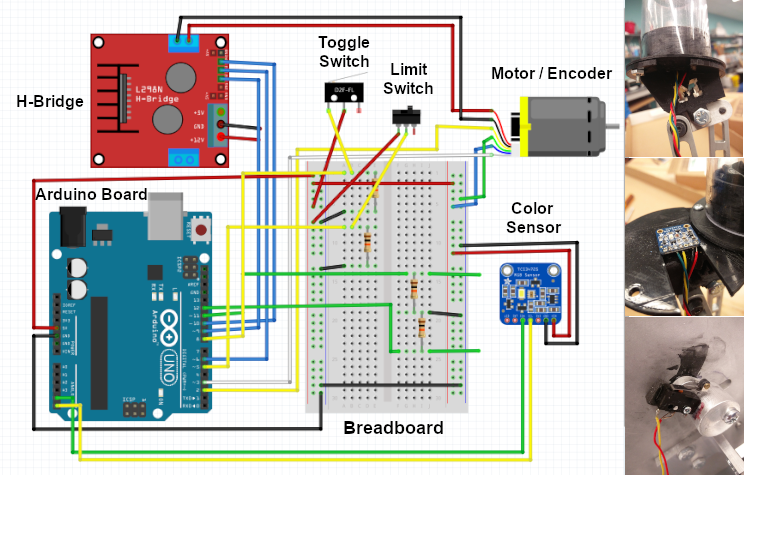
Mechatronics
Controlling the linkage in a safe and efficient manner was done through a variety of sensors. These include a color sensor, toggle switch, limit switch, and Hall Effect encoder. The color sensor was placed underneath the cup to read in the color once each ball dropped. The limit switch was mounted to the left hard stop and was used to calibrate the linkage. Each sensor was connected to an Arduino microcontroller, where we developed our own Arduino code to control the behavior of the linkage.
To tie together the mechanical linkage system with the state machine in Arduino, we designed our own circuitry that connected the microcontroller, H-bridge, motor, and sensors all together. The encoder counts for each position were found using Arduino and noting the encoder values while moving the linkage to each position with a corresponding dead band. Color sensing thresholds for each ball color were determined using RGB and Clear light sensing elements. PID values were found experimentally through an iterative process to fine-tune the motion from one position to the next.
Optimized for Efficiency
During operation, the playing field sends a signal to our mechanism indicating which chute is ready to drop a ball. Based on the color of the released ball and our linkage's position, we devised a state machine within Arduino to control its behavior using optimal positioning, sensor inputs, motor torque, and PID control. Optimizing this state machine allowed us to improve the performance of our mechanism and reduce the sorting time.
We established five key positions for our linkage: A wait position, 2 chute positions, and 2 throw positions. Before each chute ready signal, we instructed our linkage to calibrate by hitting the limit switch at the left hardstop. This ensured that the encoder counts would be within our dead band and the linkage would behave properly. Then, the linkage would transition to a "wait" state between the two chutes and wait for the playing field to signal. Next, the linkage would move to the correct chute and catch the released ball, reading in the color
Depending on the color and the chute location the linkage is positioned, there are 1 of 4 actions that can occur. If the ball is maize or blue (UofM), the ball is to be put in the basket. If the ball is red or white (Ohio State), the ball gets tossed into the net. This means that PID control needs to be implemented for each condition in order to get the behavior that we want. By fine tuning these PID gains, we could control how quickly and how accurate our linkage would peform.
During our final evaluation, our linkage sorted all 30 marbles in 1 minute, 10 seconds - an average sorting time of 2.3 seconds per ball.
Documentation -
JAMR-250: Remote-Controlled Robot
Game of Zones

Project Overview
In Fall 2017, I was the project lead for a team of 4 mechanical engineers tasked with designing and building a remote-controlled machine player (RMP) to compete in the Game of Zones robotics competition at the Michigan Design Expo. Each team is part of a squad formed by 4 teams, and the goal of the competition is to collaborate with the rest of your squad to develop a strategy to score as many cubes as possible into baskets within 5 minutes. The playing field is divided into different zones, each of which has different obstacles and challenges to overcome. Our team's strategy was to pick up cubes at the edge of one of the zones (without any border walls), and then use the extra time leftover to assist other teams in other zones of the playing field.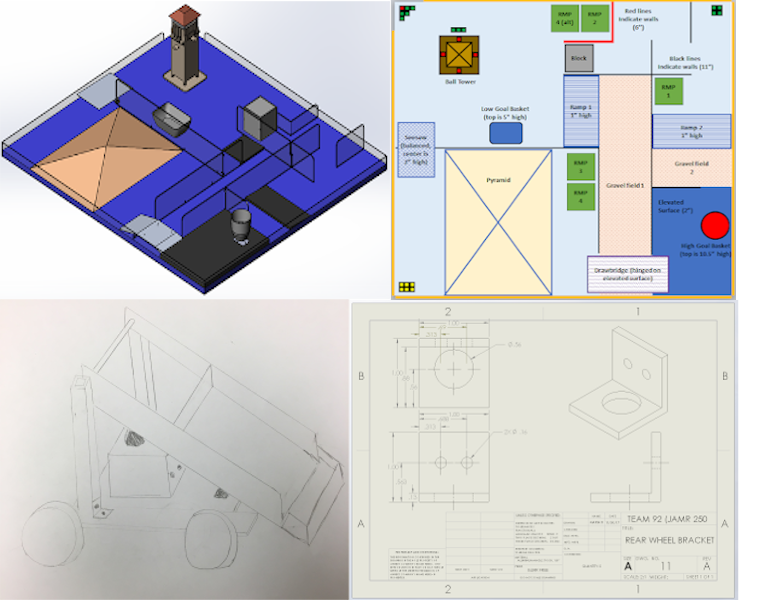
From Concept to Reality
Our robot design was constrained by the following requirements:- The RMP must fit within a 10in x 10in footprint, and must be less than 12in in height.
- No more than 4 independently controlled axes of motion (motors).
- Must be built with the provided material kit and/or less than $100 in extra parts.
- The RMP must follow proper safety procedures both in manufacturing and during operation.
Based on our design criteria and the constraints of the playing field, we started to develop JAMR-250 combining 3 three major subsystems: the drivetrain system, the ramp system, and a grabber mechanism.
Modeling & Analysis
To ensure that our final design would function properly, we carried out a detailed analysis of each subsystem and checked them against our functional requirements.
For the grabber, we had to verify that it could collect the cubes in the corner of Zone 2 and also be able to carry at least 3 cubes at a time. We decided to make a rack and pinion mechanism that could extrude out and over the cubes as needed, which allowed us to grasp onto cubes without pushing against a wall. Next, we determined that 0.4 N of force was required to firmly hold onto 3 cubes at a time - requiring a 50:1 gear ratio on our planetary gearbox motor. Finally, the grabber was found not to experience significant backdrive due to the high gear ratio, allowing it to successfully hold onto 3 cubes at once.
With the ramp assembly, we had two critical components: (1) The bent portion at the bottom of the ramp, and (2) the gear mesh at the top ramp axle. At the bottom of the ramp we settled on a tipping point such that the cubes would always fall down the ramp after being lifted a certain height off the ground. The motor at the top had to be able to lift the entire ramp assembly, which required a 99:1 gear ratio to transmit the required torque.
Lastly, we analyzed the drivetrain with two rear wheels independently powered by a double planetary gearbox and two front wheels that guide the movement of the RMP. Based on the weight of our robot and the motor specifications, we determined that a 344:1 gear ratio would provide enough power to move our robot across the table and above steep slopes. After examining the tip and slip conditions of our robot, we found that it could scale the obstacles succesfully despite the high COM without tipping or slipping.
We modeled all of our components within SolidWorks, produced drawings according to ASME-Y-14.5-2009, wrote our own manufacturing plans, and cataloged everything in a bill of materials.Final Robot
JAMR-250 has a mass of 2.7 kg, with a center of mass (length, width, height) located relative to the center of the rear left wheel of (2.42in, 4.95in, 3.23in). The final RMP fits inside a footprint of 9.25 in x 9.90 in, measuring 11.65 in tall.
Unfortunately, our robot did not perform to our expectations during competition. Even though we met all of our design requirements and passed our validation testing, we quickly observed that the set screws in our drivetrain had loosened over time and could no longer transmit the power we needed to the wheels during competition. Despite this setback, we were proud of our finished robot and we learned a lot about design along the way.
Documentation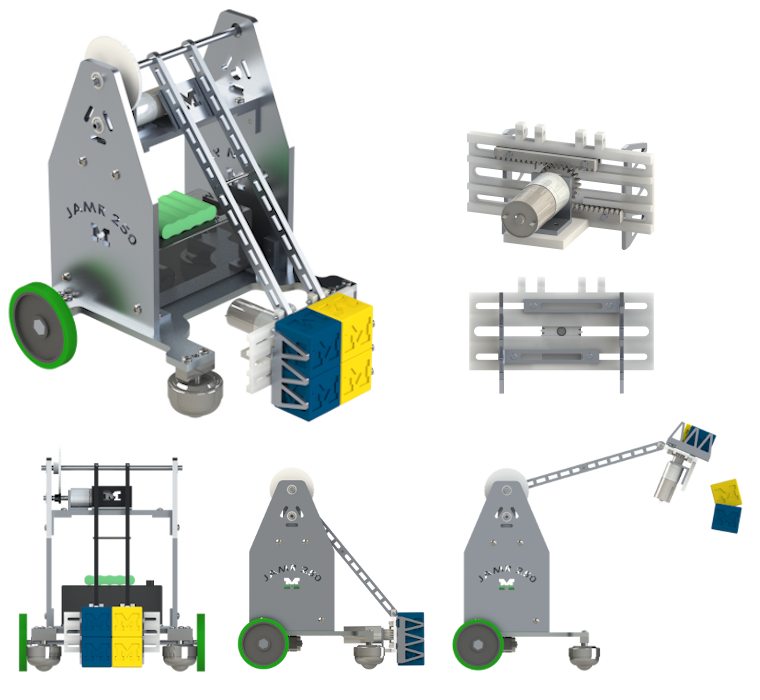
JAMR-250 - V2 Redesign
When redesigning the original JAMR-250 robot, I wanted to address 4 specific challenges that we encountered leading up to the competition:- Rotating within the small playfield oftentimes required multi-point turns, creating less consistency while turning and eating up more time. This was due to the large footprint of the RMP.
- The drivetrain spring pins loosened over time, requiring continuous repairs and modifications. Coupled with the high center of mass, this made traversing over steep slopes quite difficult.
- Due to the design of the ramp and grabber, our robot would have to turn 180 degrees and back up into the goal baskets in order to deposit cubes. This adds more complexity and uses more time.
- The design of the grabber was very complex and could be simplified down to reduce the number of components.
The use of ball casters for the front wheels greatly improves the mobility of the robot, especially in turning.
The double gearbox rear wheel drivetrain was replaced by two pololu metal motors with more reliable meshing with the axles.
The pneumatic grasper allows for the robot to easily grab cubes and deposit them without needing to rotate 180 degrees. This saves extra time per trip and reduces the complexity. In addition, the pneumatic assembly is more stable and better constrains degrees of freedom. -
Lab Research
Under Construction - Coming Soon!
-

